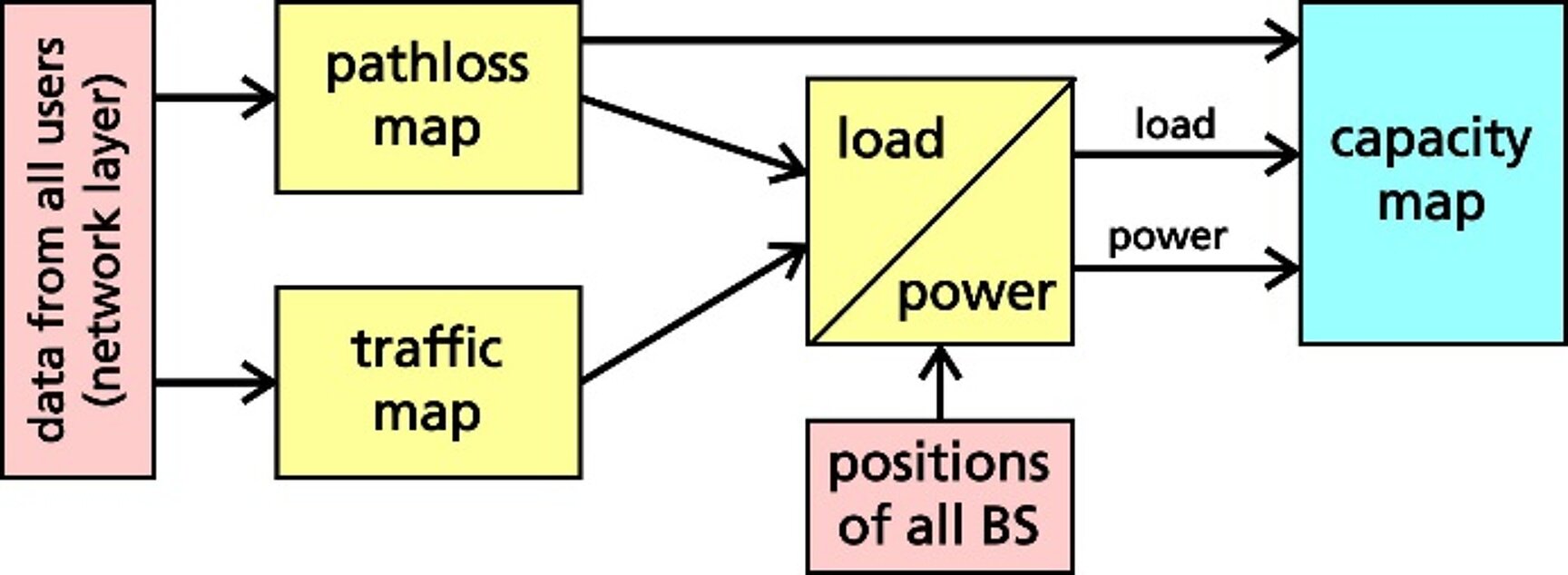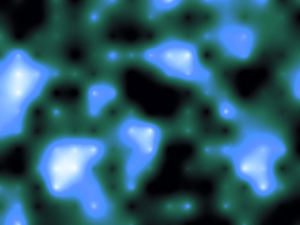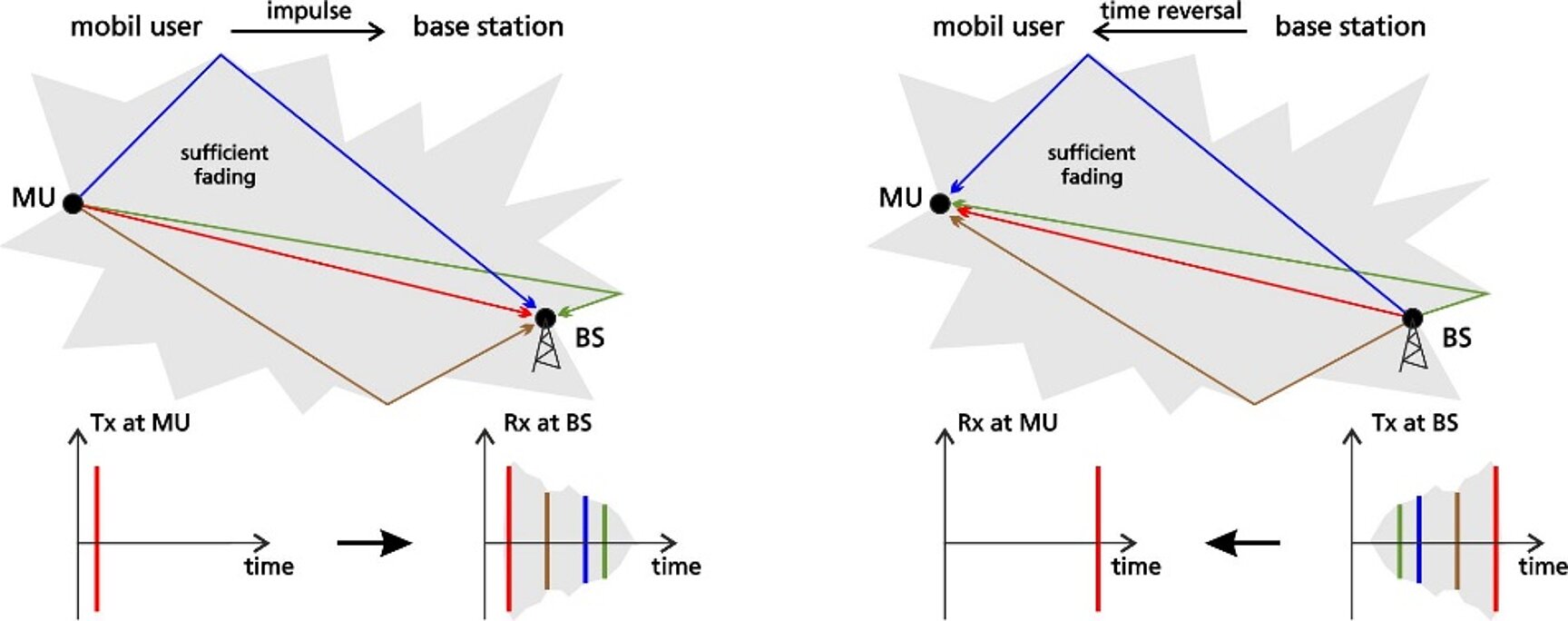Wireless networks offer a multitude of possibilities to use Artificial Intelligence profitably. To be able to employ these, the department Wireless Communications and Networks (WN) researches in the following areas:

Wireless networks and Artificial Intelligence
In the near future, control and optimization tasks in many areas of technology will become so complex that conventional optimization approaches will no longer be sufficient.
Click here, to read more about 'Wireless networks and Artifical Intelligence'
This applies in particular when real-time processing and high adaptability to constantly changing frameworks are required. These challenges can be addressed with Artificial Intelligence or Machine Learning.
The new mobile standard 5G and its potential successors provide a broad field of application. Thus, Machine Learning is one of the main research areas in the department of Wireless Networks. Innovative solutions are being pursued, by introducing new research approaches and combining previous research results with Machine Learning.
In Machine Learning, the largest possible amounts of data are evaluated using special methods enabling the researchers to draw the necessary conclusions for future decisions. The methods for these procedures are very diverse, but generally, those who have large amounts of data at their disposal are at an advantage. The reason that Artificial Intelligence is only now applied increasingly is due to the enormous computing power it requires. For many Artificial Intelligence applications, even today's computer processors (CPUs) are too slow. However, this can often be compensated by the use of very powerful graphics-based processors (GPUs).
The work on the wireless channel, which can be improved or solved with the help of Machine Learning, is divided into three areas here. First, there is the optimization of the wireless network, which due to its size and the resulting flood of data is particularly suitable for solving this task efficiently with methods of Machine Learning. Furthermore, there are methods for optimizing the data transfer to the mobile user, which are preferably executed in the network layer, but which can also be executed in the physical layer if required by the processing speed.
In addition, general considerations and further approaches are being developed, researched and investigated. Thus, among other things, interferences were evaluated to be used for learning processes [1], [2], so-called deep neural networks (see figure) were designed specifically for different problems with the help of the Laplace technique[3], [4], and distributed learning was intensively investigated with regard to various criteria [5], [6], [7], [8].

The current focus is on research activities relating to time reversal. With the time reversal, the reception pattern resulting from the fading is used in time reversal as radiation pattern, so that all portions arrive at the other receiver at the same time. With sufficient fading, it is possible to achieve a very power-efficient transmission, which can furthermore be realized with relatively simple hardware. However, in order to be able to retrieve the potential, a fast acquisition of the fading profile is of essential importance and therefore takes place in the physical layer.
References
[1] S. Limmer, J. Mohammadi, S. Stanczak, “A Simple Algorithm for Approximation by Nomographic Functions”, 53rd Annual Allerton Conference on Communication, Control, and Computing, 2015
[2] K. Ralinovski, M. Goldenbaum and S. Stanczak, Energy-efficient Classification for Anomaly Deteciton: The Wireless Channel as a Helper, IEEE ICC, 2016
[3] S. Limmer and S. Stanczak, "Optimal deep neural networks for sparse recovery via Laplace techniques," arXiv:1709.01112, Sep. 2017
[4] S. Limmer and S. Stanczak. A neural architecture for Bayesian compressive sensing over the simplex via Laplace techniques. IEEE Trans. on Signal Processing, 66(22):6002–6015, Nov. 2018
[5] R. L. G. Cavalcante, S. Stanczak, and I. Yamada, Cooperative Cognitive Radios with Diffusion Networks. IN: Mechanisms and Games for Dynamic Spectrum Allocation. Cambridge University Press, UK, 2014
[6] R. L. G. Cavalcante and S. Stanczak, "A distributed subgradient method for dynamic convex optimization problems under noisy information exchange,"IEEE Journal of Selected Topics in Signal Processing, vol. 7, no. 2, pp. 243-256, April 2013
[7] R. L. G. Cavalcante, A. Rogers, N. R. Jennings, and I. Yamada, "Distributed Asymptotic Minimization of Sequences of Convex Functions by a Broadcast Adaptive Subgradient Method," IEEE Journal of Selected Topics in Signal Processing, vol. 5, no. 4, pp. 739-753, Aug. 2011
[8] R. L. G. Cavalcante, I. Yamada, and B. Mulgrew, "An Adaptive Projected Subgradient Approach to Learning in Diffusion Networks,” IEEE Trans. Signal Processing,vol. 57, no. 7, pp. 2762-2774, July 2009

Optimization of wireless networks
The introduction of wireless networks for mobile communication made their optimization a central issue due to the ever-increasing demand.
Click here, to read more about 'Optimization of wireless networks'
With current wireless networks such as 5G, the key parameters are not only the data rate and capacity, but also requirements regarding energy efficiency, latency, eavesdropping security and others. Thus, enormous amounts of data can accumulate which can only be advantageously processed by means of Machine Learning.
The mobile terminals collect the major part of the data. Therefore, they use their transmission and additionally recorded environmental data to gain a more comprehensive overview of the mobile communication cell supplying them. Using this cognitively acquired additional knowledge, it becomes possible to act with some foresight. Further information, e.g. from the Internet, can be used to support this. For example, the automatic evaluation of an event calendar can provide the location and time of major events, which can then be taken into account in advance when optimizing a wireless network.
The long-term goal is not only to enable the individual mobile user to gain cognitive abilities with regard its immediate environment, but also to combine and further process the cognitive knowledge of all mobile users in such a way that cognitive mobile communications management is achieved, i.e. that the wireless network can control itself largely autonomously.
In order to achieve this goal, the department Wireless Communications and Networks develops, investigates and tests various methods for the optimization of wireless networks. One goal is, for example, to produce detailed maps of the entire wireless network for various relevant parameters, which can then be evaluated to achieve the best possible condition for the wireless network. Relevant parameters are, for example, the traffic density or the capacity of a network, whose relationships, including the input data used for this purpose, are shown as examples in the following figure.

Examples of topics dealt with in the department of Wireless Communications and Networks include: prediction of data traffic based on measured data including context-related additional information [1], learning so-called radio maps using measured user data [2], [3], so-called data driven methods for estimating traffic density [4], protocol questions in very dense and interfering networks [5], various approaches for determining traffic density and capacity distribution [6], [7], [8], [9], [10], measurement of interferences to detect anomalies [11] and questions of energy efficiency [12], [13].
References
[1] R. L. G. Cavalcante, S. Stańczak, M. Schubert, A. Eisenblätter, and U. Türke, "Toward Energy-Efficient 5G Wireless Communication Technologies," IEEE Signal Processing Magazine, vol. 31, no. 6, pp. 24-34, Nov. 2014
[2] M. Kasparick, R. L. G. Cavalcante, S. Valentin, S. Stańczak, and M. Yukawa, "Kernel-Based Adaptive Online Reconstruction of Coverage Maps with Side Information," IEEE Transactions on Vehicular Technology, vol. 65, no. 7, pp. 5461-5473, July 2016
[3] K. Oltmann, R. L. G. Cavalcante, S. Stańczak, and M. Kasparick, "Interference Identification in Cellular Networks via Adaptive Projected Subgradient Methods," in Proc. IEEE Asilomar Conference on Signals, Systems, and Computers, Nov. 2013
[4] D. A. Awan, R. L. G. Cavalcante, and S. Stańczak, "A robust machine learning method for cell-load approximation in wireless networks," in Proc. IEEE International Conference on Acoustics, Speech and Signal Processing (ICASSP), Apr. 2018
[5] N. Agrawal, M. Frey and S. Stanczak, A Scalable Max-Consensus Protocol For Noisy Ultra-Dense Networks. IEEE 20th International Workshop on Signal Processing Advances in Wireless Communications (SPAWC), July 2019
[6] R. L. G. Cavalcante and S. Stańczak, "The role of asymptotic functions in network optimization and feasibility studies," in Proc. IEEE Global Conference on Signal and Information Processing (GlobalSIP), Nov. 2017
[7] R. L. G. Cavalcante and S. Stańczak, "Peak load minimization in load coupled interference networks," in Proc. IEEE International Conference on Acoustics, Speech and Signal Processing (ICASSP), Mar. 2017
[8] R. L. G. Cavalcante, M. Kasparick, and S. Stańczak, "Max-min utility optimization in load coupled interference networks," IEEE Trans. Wireless Comm., vol. 16, no. 2, pp. 705-716, Feb. 2017
[9] R. L. G. Cavalcante, S. Stańczak, J. Zhang, and H. Zhuang, "Low Complexity Iterative Algorithms for Power Estimation in Ultra-Dense Load Coupled Networks," IEEE Trans. Signal Processing, vol. 64, no. 22, pp. 6058-6070, Nov. 2016
[10] R. L. G. Cavalcante, Y. Shen, S. Stańczak, "Elementary Properties of Positive Concave Mappings with Applications to Network Planning and Optimization," IEEE Trans. Signal Processing, vol. 64, no. 7, pp. 1774-1783, April 2016
[11] K. Ralinovski, M. Goldenbaum and S. Stanczak, Energy-efficient Classification for Anomaly Detection: The Wireless Channel as a Helper, IEEE ICC, 2016
[12] E. Pollakis, R. L. G. Cavalcante, and S. Stańczak, "Base station selection for energy efficient network operation with the majorization-minimization algorithm," in SPAWC June 2012
[13] E. Pollakis, R. L. G. Cavalcante, and S. Stańczak, "Traffic Demand-Aware Topology Control for Enhanced Energy-Efficiency of Cellular Networks," EURASIP Journal on Wireless Communications and Networks, vol. 2016, no. 1, pp. 1-17, 2016

Optimization of data transmission to the mobile device: Network layer
Much of the relevant data is only available on the network layer and thus allows complete statements to be made about the data rate and data quality achieved.
Click here, to read more about the 'Network Layer'
Since these are generally mobile devices, local distributions of various relevant parameters can be obtained from the data of the network layer, coupled with environmental data and the exploitation of other sources of information. This is shown schematically in the figure below, where Machine Learning methods can be used effectively, particularly because longer-term learning is possible. Hence, location-dependent additional information is obtained for the respective communication cell and parts of its adjacent neighboring cells. This allows a predictable behavior for the mobile subscribers and the wireless network to be better exploited.

Examples of topics dealt with in the Wireless Communications and Networks department include: learning of so-called radio maps using measured user data [1], [2], [3], [4] and exploiting spatial and spectral correlation to estimate the spatial distribution of path loss [5].
References
[1] M. Kasparick, R. L. G. Cavalcante, S. Valentin, S. Stańczak, and M. Yukawa, "Kernel-Based Adaptive Online Reconstruction of Coverage Maps with Side Information," IEEE Transactions on Vehicular Technology, vol. 65, no. 7, pp. 5461-5473, July 2016
[2] K. Oltmann, R. L. G. Cavalcante, S. Stańczak, and M. Kasparick, "Interference Identification in Cellular Networks via Adaptive Projected Subgradient Methods," in Proc. IEEE Asilomar Conference on Signals, Systems, and Computers, Nov. 2013
[3] Z. Utkovski, P. Agostini, M. Frey, I. Bjelakovic, and S. Stanczak. Learning radio maps for physical-layer security in the radio access. IEEE International Workshop on Signal Processing Advances in Wireless Communications (SPAWC), July 2019 (invited)
[4] M.A. Gutierrez-Estevez, R.L.G. Cavalcante, and S. Stanczak. Nonparametric radio maps reconstruction via elastic net regularization with multi-kernels. IEEE 19th International Workshop on Signal Processing Advances in Wireless Communications (SPAWC), 2018
[5] D. Schäufele, et.al. “Tensor Completion for Radio Map Reconstruction and Channel Cartography using Low Rank and Smoothness“, IEEE International Workshop on Signal Processing Advances in Wireless Communications (SPAWC), July 2019

Optimizing data transfer to the mobile device: Physical layer
The physical layer is the interface to the analog fading world and the parameters to be determined are often subject to very short-term changes, especially for mobile users.
Click here, to read more about the 'Physical Layer'
Therefore, an improvement of the parameter estimation by a longer learning time is not possible. Hence, the flow of additional information or the application of suitable models must then be used to an advantage.
One application is the determination of the current traffic density, which can be very dynamic. For this purpose, solution approaches that integrate additional information [1], [2], [3] have been developed and researched. However, faster converging algorithms can also be used successfully [4].
Another important topic is the generation of a quasi-reciprocity for frequency duplex systems (FDD-systems) in order to successfully apply massive MIMO and time reversal algorithms with these systems. The department of Wireless Communications and Networks pursues different research approaches in this area [5], [6], [7], [8].

The current research topic of time reversal (see figure) must also be established in the physical layer, because the fading properties must be clearly determined within the coherence time of the channel. This is the only way to use the receive pattern successfully to define the next transmission pattern.
Further research work of the department of Wireless Communication and Networks on the application of Machine Learning in the physical layer deals with, among other things: Cell-less systems [9], nonlinear beamforming [10], peak-to-average power ratio (PAPR) reduction [11], [12] and massive random access [13].
References
[1] D. A. Awan, R. L. G. Cavalcante, and S. Stańczak, "A robust machine learning method for cell-load approximation in wireless networks," in Proc. IEEE International Conference on Acoustics, Speech and Signal Processing (ICASSP), Apr. 2018
[2] R. L. G. Cavalcante, Y. Shen, S. Stańczak, "Elementary Properties of Positive Concave Mappings with Applications to Network Planning and Optimization," IEEE Trans. Signal Processing, vol. 64, no. 7, pp. 1774-1783, April 2016
[3] R. L. G. Cavalcante, M. Kasparick, and S. Stańczak, "Max-min utility optimization in load coupled interference networks," IEEE Trans. Wireless Comm., vol. 16, no. 2, pp. 705-716, Feb. 2017
[4] D. A. Awan, R. L. G. Cavalcante, M. Yukawa, and S. Stańczak, "Detection for 5G-NOMA: An Online Adaptive Machine Learning Approach," in Proc. IEEE International Conference on Communications (ICC), May 2018
[5] R. L. G. Cavalcante, L. Miretti, and S. Stańczak, "Error bounds for FDD massive MIMO channel covariance conversion with set-theoretic methods," in Proc. IEEE Global Telecommunications Conference (GLOBECOM), Dec. 2018
[6] A. Decurninge, M. Guillaud, and D.T.M. Slock, “Channel covariance estimation in massive MIMO frequency division duplex systems,” in IEEE Globecom, 2015
[7] L. Miretti, R. L. G. Cavalcante, and S. Stańczak, "Downlink channel spatial covariance estimation in realistic FDD massive MIMO systems," IEEE Global Conference on Signal and Information Processing (GlobalSIP), 2018
[8] L. Miretti, R.L.G. Cavalcante and S. Stanczak, „FDD Massive Channel Spatial Covariance Using Projection Methods, in Proc. IEEE ICASSP, April 2018
[9] D. A. Awan, R. L. G. Cavalcante, Z. Utkovski, and S. Stanczak, “A set-theoretic method for detection in cell-less systems,” submitted
[11] J. Fink, R. L. G. Cavalcante, and S. Stańczak, “Extrapolated Projection Methods for PAPR reduction," submitted
[12] R. L. G. Cavalcante and I. Yamada, "A flexible peak-to-average power ratio reduction scheme for OFDM systems by the adaptive projected subgradient method,” IEEE Trans. Signal Processing, vol. 57, no. 4, pp. 1456-1468, April 2009
[13] P. Agostini, Z. Utkovski, J. Pilz, S. Stanczak, Scalable massive random access in C-RAN with fronthaul limitations, submitted

Network Analytics
Network analytics provides operators and enterprises with a deep understanding of the network, enabling smarter, data-driven decisions.
Click here, to read more about 'Network Analytics'
For the currently existing radio networks, the concepts for network management and their self-organization are inadequate to cope with the growth of autonomous network elements. In particular, the question of how to deal successfully with only partial and uncertain network knowledge must be answered. Therefore, one important research topic in the Department of Wireless Communications and Networks deals with the redesigning of wireless network management mechanisms in order to eliminate, or at least mitigate the deficiencies of existing solutions. Moreover, infrastructural issues have to be identified before they can affect the quality-of-service in the network.
Hence, a thorough understanding of the complex interconnections in current and future communication networks is essential. In particular, this enables smart optimization decisions, including the goal of optimal use of the scarce resource, while simultaneously improving the quality-of-service (QoS) of all users.
Modern communication networks can be seen as big, evolving distributed databases full of context and information available from handheld devices (e.g., mobility information), the network itself (e.g., the current load of a base station), and the environment (e.g., predicted user trajectories). In the Department of Wireless Communications and Networks, novel knowledge extraction mechanisms and predictive analytics tools are developed and integrated, which have extremely large amounts of data to enhance decision-making processes throughout the network. This knowledge has a plethora of applications, including real-time system identification and network-wide self-optimization of wireless networked entities. In particular, the extracted information can be used for demand modelling, anticipatory buffering, anticipatory handover, anticipatory traffic offloading, inter-cell scheduling, and many more.